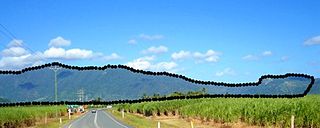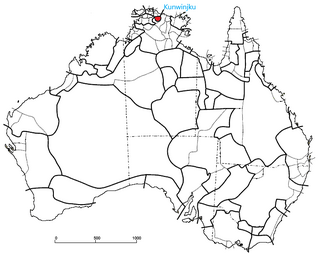
Australian Aboriginal religion and mythology is the sacred spirituality represented in the stories performed by Aboriginal Australians within each of the language groups across Australia in their ceremonies. Aboriginal spirituality includes the Dreamtime, songlines, and Aboriginal oral literature.

The Murrinh-Patha, or Murinbata, are an Aboriginal Australian people of the Northern Territory.
Ngan'gi, formerly known as Ngan'gityemerri, and also known as Ngan'gikurunggurr, Moil/Moyle, Tyemeri/Tyemerri, Marityemeri, and Nordaniman, is an Australian Aboriginal language spoken in the Daly River region of Australiaʼs Northern Territory. There are three mutually intelligible dialects, with the two sister dialects known as Ngen'giwumirri and Ngan'gimerri.

The Daly languages are an areal group of four to five language families of Indigenous Australian languages. They are spoken within the vicinity of the Daly River in the Northern Territory.

The Kunwinjku people are an Australian Aboriginal people, one of several groups within the Bininj people, who live around West Arnhem Land to the east of Darwin, Northern Territory. Kunwinjku people generally refer to themselves as "Bininj" in much the same way that Yolŋu people refer to themselves as "Yolŋu".
The Ayapathu people, otherwise known as the Ayabadhu or Aiyaboto, were an Indigenous Australian group, living on the western side of the Cape York Peninsula in northern Queensland.
The Mati Ke, also known as the Magatige, are an Aboriginal Australian people, whose traditional lands are located in the Wadeye area in the Northern Territory. Their language is in danger of extinction, but there is a language revival project under way to preserve it.
The Marrithiyal, also written Marrithiel, are an Aboriginal Australian people whose traditional territory lay 100 to 130 miles south of Darwin from Litchfield National Park and extend to the Daly River in the Northern Territory. They are also known as the Berringen people to represent their affiliation and deep connections across the neighbouring South Western Daly region.
The Mulluk-Mulluk, otherwise known as the Malak-Malak, are an indigenous Australian people of the Northern Territory, Australia.
The Madngella, otherwise known as the Matngala or Hermit Hill tribe, are an indigenous Australian people of the Northern Territory, Australia.
The Marranunggu are an Aboriginal Australian people and language group, of the Northern Territory.
The Maridan were an indigenous Australian people of the Northern Territory.
The Wulwulam, also known as the Woolwonga, were an indigenous Australian people of the Northern Territory. They are reputed to have been almost completely exterminated in the 1880s in reprisal for an incident in which some members of the tribe speared 4 miners.
The Maringar are an Aboriginal Australian people of the Northern Territory.
The Djerait were an indigenous Australian people of the Northern Territory
The Pongaponga were an indigenous Australian people of the Northern Territory. They may have been a band of the Ngolokwangga.
The Ngolokwangga are an Aboriginal Australian people of the Northern Territory.
The Yunggor were an Aboriginal Australian people of the Northern Territory.
The Muringura, or Murrinh-Kura, were an indigenous Australian people of the Northern Territory.
The Wagiman, also spelt Wagoman, Wagaman, Wogeman, and other variants, are an Aboriginal Australian people of the Northern Territory.